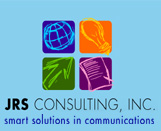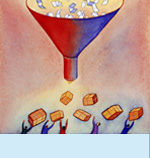


  |
||||
|
PRINTER FRIENDLY VERSION Maximizing the Value of Communications: Conducting a Communications Audit/Assessment Do your employees have the information they need? What's the most effective way to reach your customers and really get their attention? Are there any barriers preventing your organization from achieving maximum growth? A communications assessment, or audit, determines and improves the value of communications both within an organization as well as to key outside audiences. Here's a quick example. The president of a human resources consulting firm retained JRS Consulting to address why her company's growth had recently slowed dramatically. Her three–year-old organization had grown exponentially and she had added six staff members in the last year alone to accommodate her expanding client base. But within the past five months, business had decreased unexpectedly. JRS's confidential interviews with customers and employees revealed an interesting phenomenon. While customers continued to respect and value the firm's charismatic president, their experiences with her rapidly expanding staff weren't as positive, and they felt cut-off from the firm's president. Staff members, in turn, sensed this issue but they were reluctant to bring it to the president's attention because they felt it would reflect poorly on them. Instead of facilitating the president's involvement in critical client relationships, they perceived their jobs to focus on freeing the president from client contact. Clients were leaving because they weren't receiving the attention to which they were accustomed. JRS worked with the firm to improve the channels of communications. Training with staff improved their client relations and clarified expectations for involving the firm's president at key junctures. The president personally contacted clients to communicate how she valued their business and her ongoing involvement in their programs. The assessment identified a critical break in communications at this company and provided input into how to repair it and get the company back on the track for success. OVERVIEW OF THE ASSESSMENT PROCESS A typical assessment involves a series of steps that begin by broadly identifying the major areas of communications within the company. We then identify communications successes and weaknesses in order to focus communications planning on the most actionable areas with the highest potential rewards for the organization and its audiences. We prefer to use the word "assessment" rather "audit" because we find that "audit" is associated with uncomfortable topics like tax returns for most people. We refer to our needs-based analyses as communications assessments because our process focuses on identifying and enhancing value. Our overall approach for an assessment usually involves four to five steps, although each assessment is customized to meet client needs (for example, it is not always necessary to conduct a survey): 1. Analyze existing communications vehicles 2. Conduct executive interviews 3. Facilitate employee and management focus groups or interviews 4. Coordinate a communications survey (as appropriate) 5. Develop a needs-based communications plan 1. Analyze existing communications vehicles In this step, we assemble samples of the communications vehicles distributed to your target audiences and evaluate each one for effectiveness, accessibility and timing. It is helpful to prepare a master chart for plotting all of the vehicles so that your team can determine which stakeholders are receiving what media as well as the overall volume and timing of communications in distribution. You can get additional input on communications vehicles from employees in interviews, focus groups and surveys, as outlined below. Communications gaps sometimes surface in this review. For example, one client we worked with had reorganized and assigned a third of its workforce to work remotely. However, they didn't provide these employees with any of the tools they needed to work from these locations. Without fax machines or high-speed connections, employees were sometimes waiting up to three hours to download documents. As a result, they were frustrated and failed to receive timely information. 2. Conduct executive interviews Here, we conduct interviews with executives to ensure that the communications assessment reflects their issues/concerns for the organization's success — beyond those of the communications department. One-on-one interviews with executives should explore the following areas: • Their view of the role/purpose of employee communications in the organization. • How they visualize ideal communications. • What they expect each team member to know about the company. • Communications strengths and weaknesses (includes subjects being communicated and the media currently employed). • Major company goals that are communications sensitive. • What they think team members want to know about. Interviews should be conducted with senior management of the overall organization. They can be conducted in-person or over the telephone and should last from 30-40 minutes. 3. Facilitate employee and management focus groups or interviews Step three involves conducting focus groups of 8-12 employees and managers, with employees and managers in separate groups so that respondents feel comfortable expressing their views. If geographic dispersion prevents the use of focus groups, then telephone interviews with employees and managers can be conducted. The content of the discussion is similar to that of the executive interviews, with group discussion for the focus groups. The focus groups/interviews allow us to compare employee/management attitudes with executives' perceptions. For example, one division director retained us because he wasn't getting the regular flow of information he needed from his staff. While information flowed well at times, there were days when he failed to get the updates he needed. Staff interviews revealed that their director's moods varied so greatly that they had instituted a "red light/green light"system outside of his office. On days with a green light, they felt free to approach him. But when the red light was out, they avoided him because of his angry outbursts. Communications consulting benefited this director and led to a greatly improved information flow with his staff. Of course, not every team member can be a participant in a focus group or interview. Choose team members that represent your important audiences, taking care to include any audiences that you believe may have particular communications issues. For example, if some employees don't have access to computers or voicemail, they may have particular communications needs and it would be wise to include them in a focus group. When identifying who to invite, include both positive and negative vantage points and a mix of gender, tenure and personality styles. The focus groups should last from 60-90 minutes and can be held in a conference room. You should plan to recruit about 20% more respondents than you think you will need to allow for last-minute cancellations. For example, if you want 12 people in your focus group, plan to recruit 15. 4. Coordinate a communications survey (as appropriate) A survey obtains hard numbers that serve as a baseline for measuring future improvements and identifying differences between various audience sub-groups. It may not always be necessary to conduct a survey, particularly for smaller organizations. However, for larger organizations with business units or divisions, a survey can provide very effective direction for development of a communications plan as well as allow measurement of communications over time. For example, our survey research helped the communications director of a large organization to implement our research-based communications plan. The research showed that the number of employees who received the information they needed increased from 47% to 79% over two years. The value that employees placed upon internal communications also multiplied dramatically, leading to a department in great demand. The survey contains questions about communications with multiple-choice responses. Results can be statistically analyzed and compared with new results over time to gauge improvement. The questions include the following areas: • General attitude questions (credibility, timeliness, upward communications, horizontal communication). • Distribution/effectiveness of key media. • Follow-up questions based on executive interviews and focus groups. • One or two write-in questions. • Demographic questions to identify differences between sub-groups. Before distributing the survey, it's a good idea to test it on several members of your target audience to make sure that your instructions and questions are clear. Accompanying the questionnaire with a letter from senior management asking for participation will encourage a better response rate. 5. Develop a needs-based communications plan It's time to put the results into action! This critical finale to the assessment process is the ultimate benefit of a communications assessment — delivering a strategic communications plan based on key stakeholder needs. The introductory part of the communications plan should report relevant research findings that will lead into the communications recommendations. The research will identify needs that the communications plan can then address. For example, if team members have reported that they are receiving information in inconsistent ways and their managers feel confused about when to use particular media, then development of a communications protocol for the department will be a logical way to address this need. The communications assessment findings serve as both a baseline and a springboard for developing an outstanding and targeted communications process that all involved know will be effective because it is based on solid research findings. NEXT ARTICLE Jenny Schade is president of JRS Consulting, Inc., a firm that helps organizations build leading brands and efficiently attract and retain employees and customers. Subscribe to the free JRS newsletter on www.jrsconsulting.net/newsletter.html © JRS Consulting, Inc. 2007 |
 |
|||
© 2008 JRS Consulting, Inc.